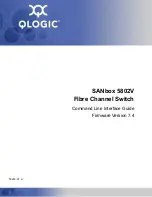
Chapter 2: Introduction
724-746-5500 | blackbox.com
Page 25
collisions, to be forwarded to add to the network traffic. Since there is no
way to filter frames with a bad CRC (the entire frame must be present in
order for CRC to be calculated), the result of indiscriminate cut-through
forwarding is greater traffic congestion, especially at peak activity. Since
collisions and bad packets are more likely when traffic is heavy, the result
of store-and-forward operation is that more bandwidth is available for
good packets when the traffic load is greatest.
To minimize the possibility of dropping frames on congested
ports, each LBH21-Series Converter Switch dynamically allocates buffer
space from 64Kb memory pool, ensuring that heavily used ports receive
very large buffer space for packet storage. (Many other switches have
their packet buffer storage space divided evenly across all ports, resulting
in a small, fixed number of packets to be stored per port. When the port
buffer fills up, dropped packets result.) This dynamic buffer allocation
provides the capability for the maximum resources of the LBH21-Series
unit to be applied to all traffic loads, even when the traffic activity is
unbalanced across the ports. Since the traffic on an operating network is
constantly varying in packet density per port and in aggregate density, the
LBH21-Series Converter Switches are constantly adapting internally to
provide maximum network performance with the least dropped packets.
When the Switch detects that its free buffer queue space is low,
the Switch sends industry standard (full-duplex only) PAUSE packets out
to the devices sending packets to cause “flow control”. This tells the
sending devices to temporarily stop sending traffic, which allows a traffic
catch-up to occur without dropping packets. Then, normal packet
buffering and processing resumes. This flow-control sequence occurs in
a small fraction of a second and is transparent to an observer.
















































